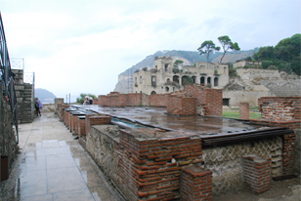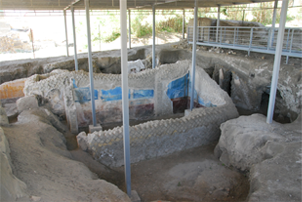This section includes a few of the smaller sites which are either open or are sometimes open. They are all demanding or challenging journeys from the train station. We have included them for those readers who have a specialist interest and who would appreciate a little help to find their way.
The idea for this section of the website came after the author tried to find a site starting from the wrong station, the section for advanced travellers should help others to avoid making the same mistakes.
Posillipo
Why should you go to Posillipo?

Posillipo was an imperial villa, it was left to the Emperor Augustus by Publius Vedus Pollio for the use of all future emperors. We know that the poet Virgil visited Augustus in this house and it is very likely that he stood and recited on the stage of the small theatre which can be seen on site. Augustus would have sat in the middle of the front row of seats. The position of the villa is stunning, on a headland with fabulous views. This is the villa in which Pollio, being a bit miffed that one of his slaves had broken a crystal cup whilst serving dinner, ordered that he should be fed to the lampreys which he kept in his private fish ponds. His guests were so appalled that they all dropped their food laden, gold plates into the fish tanks. Pollio felt obliged to reverse his decision. It should be noted that this story has a few variants and might not be the entire truth.
The site is massive, unfortunately only a very small portion of it has been excavated. You should not expect to see an imperial villa, just a few ruined rooms, two theatres and the most amazing views.
Another aspect of Posillipo is that it is approached by a 700 metre tunnel which is so big that it does not need the artificial lighting with which it has been fitted. This might appear to be extravagant until you recall that Roman waterproof concrete is made from pozzuoli which is a form of volcanic ash. Pollio would have needed lots of it for his fish tanks and probably took a few contracts to supply it elsewhere as well. The hill through which he tunnelled is mostly made of pozzuoli, the remainder being a limestone which is usable as building material.
Why are we not telling everyone to go there?
It is a tough journey and there are restricted opening times as a result of the need to walk through the tunnel. The tunnel is gated at both ends. At the time of writing (2022) the opening times vary with the day of the week so you need to check the website before visiting the site.
Beware: the weblink above might change and there are a number of out of date pages on the web. This is a trip for the more experienced traveller.
The journey by train and walking involves using the Cumana Line which, as I have mentioned in the appropriate place, can be erratic, there is then a mile and quarter walk to the entrance of the tunnel through a very uninteresting area. It used to be a steelworks. The 700 metre tunnel follows and there is about 300 metres beyond that to get to a relatively limited site.
How to get there?
The train service to use is the Cumana Line from Montesanto Station in Naples. If you are buying a ticket in Naples then there should not be any trouble asking for a ticket to Bagnoli, which is your destination. Some of our readers will be coming from other parts of the Naples transport network, perhaps the Circumvesuviana, it is probably wise, unless you have good Italian, to print a copy of the map of the Cumana Line, we provide a link to it in the trains section of this website, and to circle the station that you want. The author once spent two and a half minutes, speaking Italian, trying to convince a ticket seller on the Circumvesuviana that the station that he wished to go to existed and that he fully understood that it was on the Cumana Line.
The station that you want is Bagnoli. Unfortunately a number of stations on the Cumana Line do not have evident signboards. If you don't know the Cumana Line keep a count of where you are by checking off the stations on a map. Incidentally these problems do not occur if you are going to Pozzuoli or beyond. Pozzuoli is a nice place.
Leaving Bagnoli Station there are two streets across the road which passes in front of the station, take the right hand one and walk a short distance to a road which runs parallel to the sea. Turn left onto this road and proceed along it entirely across the floor of the valley in which you find yourself. As the road reaches the other side of the valley you will notice that it turns left and starts to zigzag up the side of the hill, there are steps which offer a shortcut up to the next level of the zigzag road. At the top of the second set of steps you will be facing the entrance to the tunnel. The entrance to the tunnel is enormous, you won't miss it.
At some time in the future a revision to the railway service in this area is planned which will include a station at Coroglio, the village in the valley immediately below the entrance to the tunnel. This page will be updated when this has happened.
Bagnoli is within the Naples conurbation so that, if you are using a Giornaliero (day ticket), it will be valid for this journey.
The author was at Bagnoli in 2018 but did not walk the full journey, it being too hot on that day.
Villa Sora
Can you visit Villa Sora?

Villa Sora is in Torre del Greco and is maintained by a local voluntary organisation. It is normally closed but there are a few days during the year when it is opened by the volunteers. This note should help specialists to find it on those few days. The author found that enquiries from the public resulted in either no knowledge of the site or a vague wave in the correct direction which proved to be misleading.
Why would you want to go there?
To be honest with you, you probably wouldn't. It is a very small excavation in, what was once, an enormous villa. Your guides will tell you that the villa of which this tiny excavation is a part included a kilometre of the sea shore. During the eruption of Vesuvius Pliny the Elder set out with his fleet to rescue the trapped inhabitants prompted by a request from Rectina, wife of a prominent citizen. We do not know where Rectina lived but, if the villa was a kilometre long, and it is in approximately the correct place, perhaps this was Rectina's house.
How to Get There
The station is Via San Antonio on the Circiumvesuviana line to Sorrento or Poggiomarino. If you turn left out of station and then follow round to the right you will find that you are proceeding downhill away from Vesuvius and towards the sea. You will arrive at a main road and a roundabout. Cross it and walk on downhill on the road which is slightly to your right as you approached the main road. Effectively you will be continuing in a straight line.
After approximately half the distance that you will have covered to get to the main road you will arrive at another roundabout with a form of public park beyond it. You need to turn right onto the road which runs parallel to the sea. As you walk, on your left hand side, the park will be quickly replaced by commercial buildings. The first road to the left looks like no more than an access road, the Via del Cimitero, but you need to turn into it. A short way down this road, there is an old building on your left with an arched gateway which leads to a cultivated area, go through this arch and follow the dirt track down towards the sea. You will be walking around the edge of the field. The track turns left and then right and crosses a hummock of rough ground. The site will be seen as a sheet metal covered area to your right between the hummock and the railway line.
The author last travelled to this site a lot of years ago, before the commercial development beside the main road.
Future Development
It is planned to add more routes to this section of the website as they are explored.